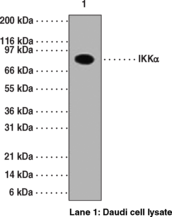| References |
| Synonyms |
|
| Formulation |
100 µg of protein G-purified IgG in 200 µl PBS, containing 0.0.5% BSA and 0.05% sodium azide |
| Stability |
1 year |
| Storage |
-20°C |
| Shipping |
Wet ice
in continental US; may vary elsewhere
|
| Specificity |
| Human IKKα |
+ |
| Monkey IKKα |
+ |
| Mouse IKKα |
+ |
|
| Size |
Global Purchasing |
| 1 ea |
|
Description
Antigen:
his-tagged full-length recombinant human IKKα
·
Clone designation:
14A231
·
Host:
mouse
·
Isotype:
IgG1κ
·
Application(s):
FC (intracellular), IHC (paraffin-embedded sections), IP, and WB
·
Nuclear Factor-κB (NF-κB) is sequestered in the cytoplasm by the IκB family of inhibitory proteins that mask the nuclear localization signal of NF-κB, thereby preventing translocation of NF-κB to the nucleus. External stimuli such as tumor necrosis factor or other cytokines result in phosphorylation and degradation of IκB, releasing NF-κB dimers. NF-κB dimers subsequently translocate to the nucleu and activates target genes. Synthesis of IκBα is autoregulated. IκB proteins are phosphorylated by IκB kinase complex consisting of at least three proteins, IKK1/α, IKK2/β, and IKK3/γ. In vitro, IKK1/α and IKK2/β can form homo- and heterodimers that can phosphorylate IκBs at the regulatory serine residues directly. IKK1/α and IKK2/β are phosphorylated by NF-κB-inducing kinase (NIK) and MAP kinase kinase-1 (MEKK-1), respectively.1 Targeted disruption of IKK1/α gene in mice results in skin and limb abnormalities and death of newborns.2,3
1
Delhase, M., Hayakawa, M., Chen, Y., et al. Positive and negative regulation of IκB kinase activity through IKKβ subunit phophorylation. Science 284 309-313 (1999).
2
Takeda, K., Takeuchi, O., Tsujimura, T., et al. Limb and skin abnormalities in mice lacking IKKa. Science 284(5412) 313-316 (1999 Jun 9 1999).
3
Hu, Y., Baud, V., Delhase, M., et al. Abnormal morphogenesis but intact IKK activation in mice lacking the IKKa subunit of IkB kinase. Science 284(5412) 316-320 (1999 Apr 9 1999).
|






